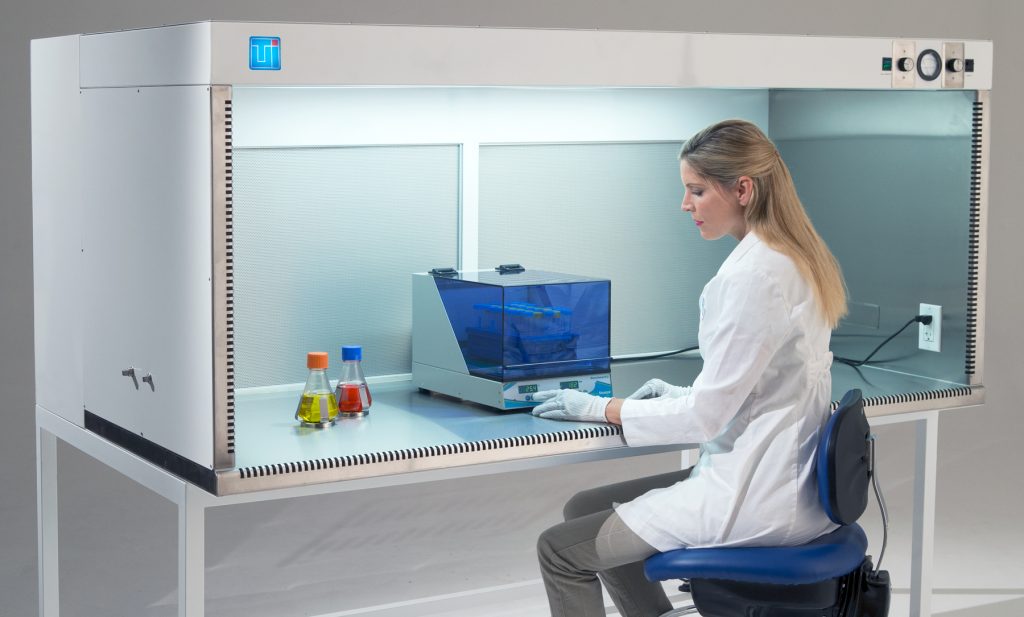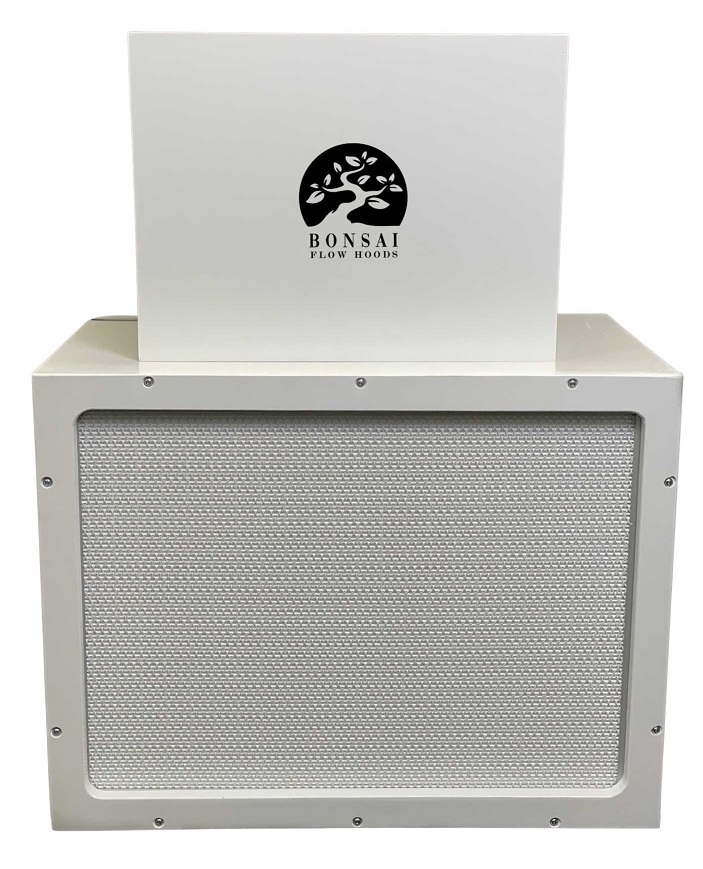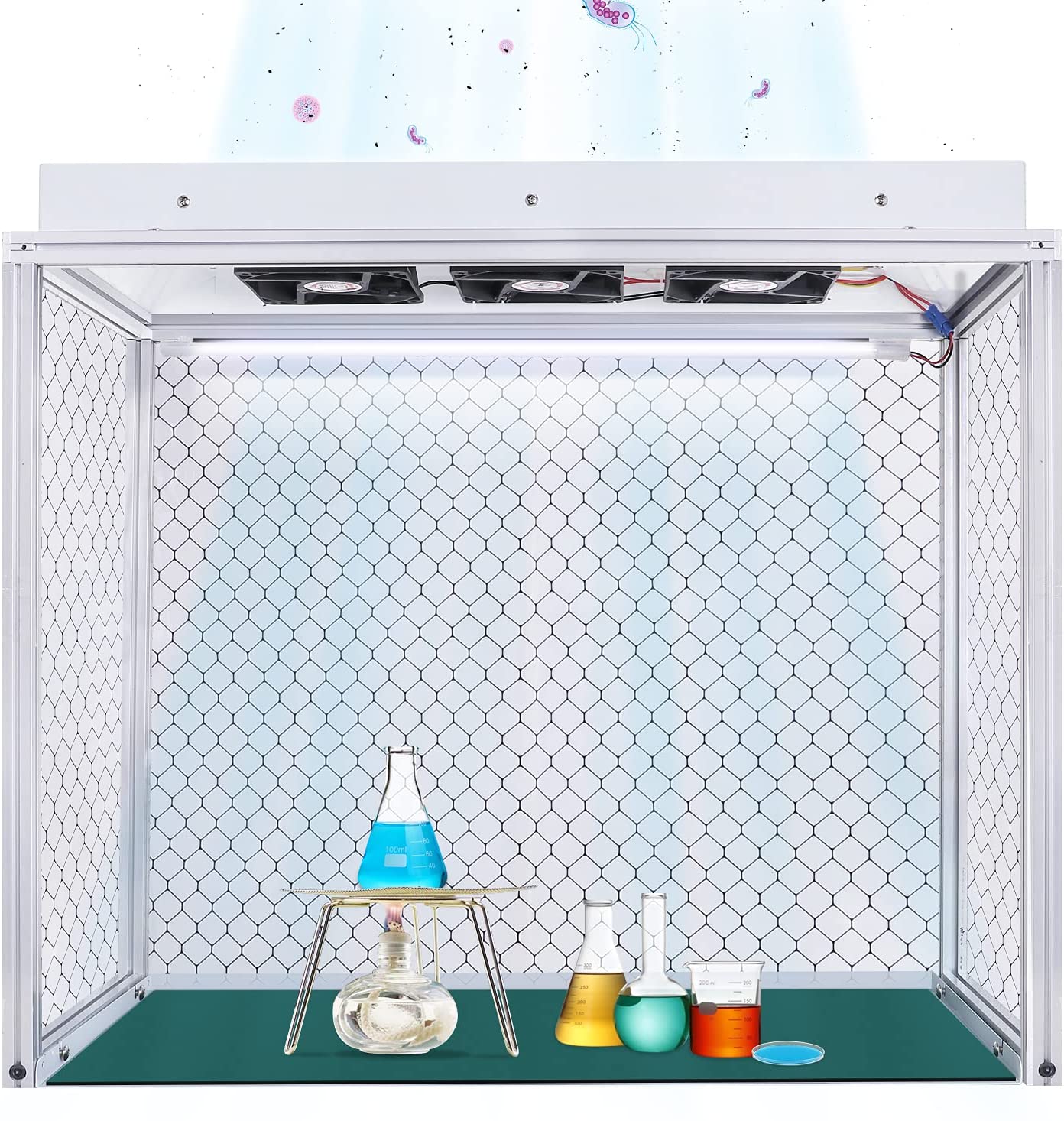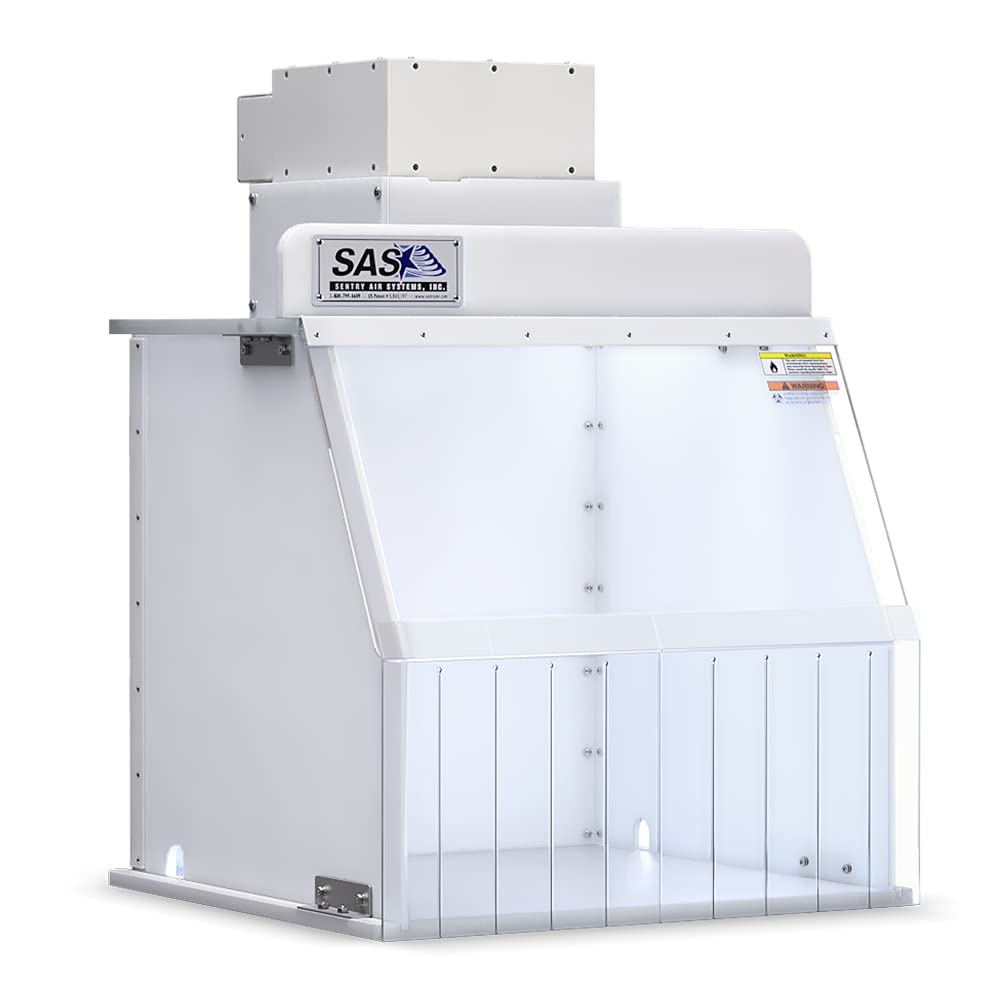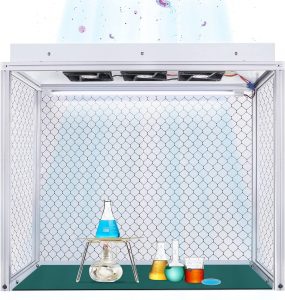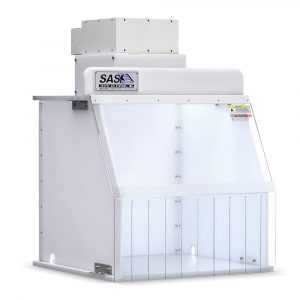Laminar flow hoods are essentially boxes that prevent airborne contamination by directing, rather than preventing, airflow.
“Laminar flow” means a mass of air all moving in the same direction at the same speed, without eddies or other complication. So, for example, if somebody is working on a project that produces unhealthy dust, and the flow hood sucks air in past the worker, across the project, and then through a filter, then laminar flow means none of that dust will end up in the worker’s face—nothing moves backwards against the direction of the flow. Flow hoods can also move air in the other direction, in through a filter, across the project, and then out towards the worker, if the idea is to protect the project (rather than the worker) from contamination.
Laminar flow hoods are used by mushroom growers and mycologists who are inoculating agar plates or otherwise working with living fungal tissue highly vulnerable to contamination by airborne molds, bacteria, or other problems. Flow hoods are also used by people conducting medical or biological research, and by people working with dangerous chemicals. If the absolute security of a well-designed glove box (a box completely sealed against outside air, accessible only through gloves sealed to access holes) isn’t necessary, a laminar flow hood protects against contamination while allowing complete freedom of movement by the worker through the open front.
IMAGE | PRODUCT | Header | ||
|---|---|---|---|---|
OUR #1 RATED 110V Plug & Play, 99.99% Micron Filter designed to last 3-5 years, Removeable CNC Face Plate. | ||||
99.99% HEPA Filter, ISO 5, FED 209E, Class 100. | ||||
Reduced Particle environment, ISO Class 5, Includes: LED Light, Anti-static Curtains, Variable Speed, and filter. | ||||
Vertical vs Horizontal
A laminar flow hood can either a vertical configuration or a horizontal configuration[i]. The difference is whether the fan that moves the air is above the work area or beside it. Vertical hoods take up less floor-space and can be installed as an attachment over a standard work-bench. Unfortunately, the work area is typically smaller, and you may need a step-ladder to service the fan. Conversely, horizontal flow hoods are both roomier and bulkier.
Buy or Make?
Laminar flow hoods can be purchased ready-made, but it’s also possible to make a simple one at home. There are pros and cons to each option[ii].
The greatest advantage to building at home is cost—a professionally made unit is likely to cost twice as much for similar size and quality. The disadvantage is that building a flow hood takes both time and skill, and not everybody has either. The choice is going to come down to what kind of quality you need and what kinds of resources you have.
If you are good at DIY projects and short on cash, making a flow hood is the obvious choice. If money isn’t a problem but you’re in a rush, then buying is by far the better option. If you’re only moderately handy but don’t actually need high quality for this particular project, then making a very simple flow hood is a great way to save money. The thing to avoid is any compromise on needed quality—if your project requires a better flow hood than what you can make, then either buy one or abandon the project. This is safety equipment we’re talking about here.
Best Laminar Flow Hoods to Buy
The “best” flow hood is a little difficult to determine, but we can offer a few examples of good products. Both of the following models have strong reputations and are good options for use with mushroom cultivation.
Bonsai
This is my top Laminar Floor Hood for Mushrooms on the market. This is the one that is considered the industry standard. The bonsai is a 99.99% Hepa Horizontal Laminar Floor Hood. They are for personal use but have the backing of experts in the bio and pharmaceutical industry. Your work space will be kept 99.99% sterile.
This hood is great if you want to
- Work with Agar Plates
- Create your own spore syringes
- Execute grain to grain transfers
- Clone, Isolate etc…
Features included with the Bonsai:
- 110V Plug & Play
- Made out of 3/4 cabinet grade birch
- Removeable CNC Face Plate
- Side air buffers
- 99.99% Micron Filter designed to last 3-5 years
- Guide & Manual on making Spore Syringes, Agar etc
- 1 Year Warranty.
You can buy our #1 Pick, the Bonsai Laminar Flow Hood here.
YJINGRUI
Using YJINGRUI products is kind of half DIY. You can buy all the individual components and plug and play them to make a high quality Laminar Flow Hood. For example if you buy their fan it includes only the filter and fan unit; and it would have to be mounted on a suitable box, most likely in a vertical configuration. It doesn’t come with a pre-filter, either; the company recommends the user add their own pre-filter, if desired. That being said, the unit gets strong reviews and I have personally used it.. The negative reviews almost entirely involve customers whose purchase was damaged during delivery, not complaints about the product itself. The filter is 99.99% efficient, and the fan has three speed settings. It offers a kind of middle ground between buying and making and is priced accordingly.
I highly suggest this route, you can see all the configurations you can do with Yjingrui at their store.
18” Wide Portable Clean Room, by Sentry Air Systems, Inc.
Here is a more elaborate and more complete flow-hood—some assembly is required, but this is a complete work station. It even includes its own overhead light. Whether the flow is strictly laminar is debatable, but it does appear to be an effective positive-pressure clean work area. Reviews are strong, and most negative reviews are about the lack of assembly instructions, not any problem with its function. Though not cheap, the price is about typical for professional-quality flow hoods. This is a really good option but it’s about how much you value your time at and the amount of customizations you can do. This is a buy once cry once type of purchase that out of the box is the most ready system. However; you can’t do as many customizations as say the Yjingrui.
You can buy the Sentry Air Systems Laminar Flow Hood Here.
How to Make a DIY Laminar Flow Hood
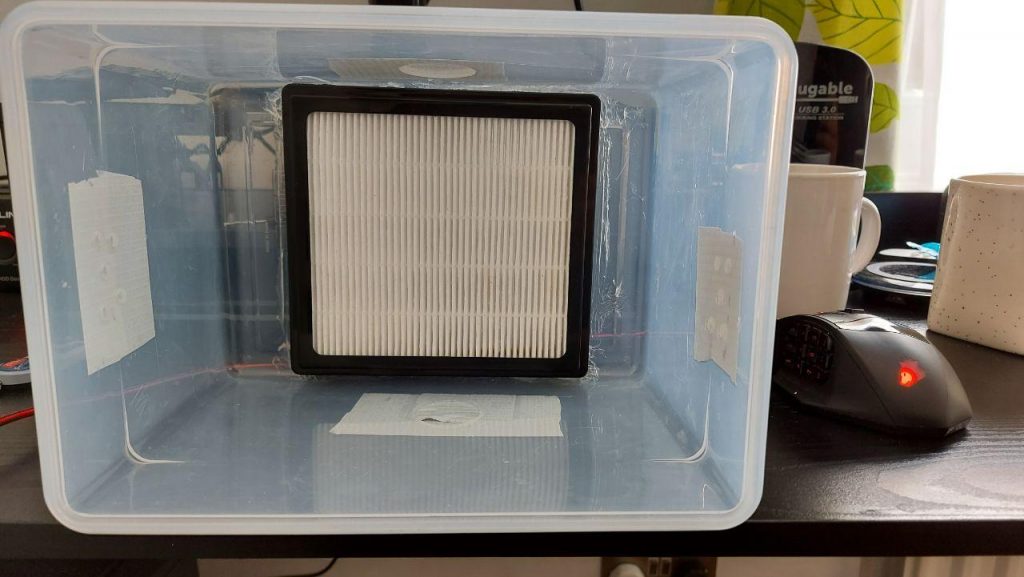
There are two main approaches to making your own laminar flow hood: “high-quality”[iii] and “good enough”[iv]. The latter is far cheaper and simpler to make, but its flow may not be completely laminar, meaning contamination is possible (just very unlikely). Clearly, there are circumstances where “good enough” isn’t good enough, but some mushroom growers get good results with cheap, home-made flow hoods. Because instructions for a high-quality hood are quite technical (and available online elsewhere), we’ll provide only the “good enough” version here, but with a few notes on what the differences are.
Note that these instructions are for a hood with the flow moving outward—the set-up that a mushroom-grower needs to prevent contamination. Someone with a project involving dangerous fumes or something similar would need a flow hood that flows the other way.
Materials Needed
- Plastic box 23cm wide (9 inches), 15cm long (6 inches), 15cm deep (6 inches). Flow hoods can vary in size, but if you use a bigger box, you may need a different filer and a different fan. Any tote on Amazon with these general dimensions should work.
- HEPA filter—H14 Nilfisk Non-Original H14 Extreme Series (or equivalent)
- Fan—Noctua NF-F12 iPPc 3000 PWM, 4-Pin, 3000 RPM (or equivalent)
- 12V PC to Plug adapter
- Sealant
- Hot knife
- Adhesive tape
- Some object to hold the fan in place (book-end, keyboard, etc.)
- Lighter (or similar flame source)
Step by Step Instructions
- Use the hot knife to cut a hole in the bottom of the box of the right size and shape to fit the filter snugly. Note that the bottom of the box will become the back of the flow hood.
- Put the filter in the hole and seal the contact between the filter and the box. The sealant will need time to set.
- Tape the box to whatever surface you want it sit on. Otherwise, it might move around a bit.
- Set the fan up right behind the filter. This may require stabilizing the fan with an object or two. Since the fan is designed for use with a computer, you’ll need the adapter to plug the fan in.
- Turn the fan on high. Test the flow hood with a small flame—if the flame bends over in the breeze but doesn’t flicker or dance, then you have laminar flow.
When not in use, the box can be un-taped from its surface and it and its fan stored away.
Note that the above design uses easy-to-find components that might not be ideal, plus it lacks a plenum—an enclosed area behind the filter that allows the air pressure from the fan to even out across the filter surface. Cutting such corners means this flow hood can be built for less than a hundred dollars with little time or skill required, but its performance is only “good enough.” Its flow may not be quite laminar. To make a higher-quality flow-hood, it’s necessary to pay more attention to buying exactly the right filter and fan. Custom building your own box out of plywood, rather than relying on something store-bought and plastic, will give you a lot more flexibility in terms of size and shape.
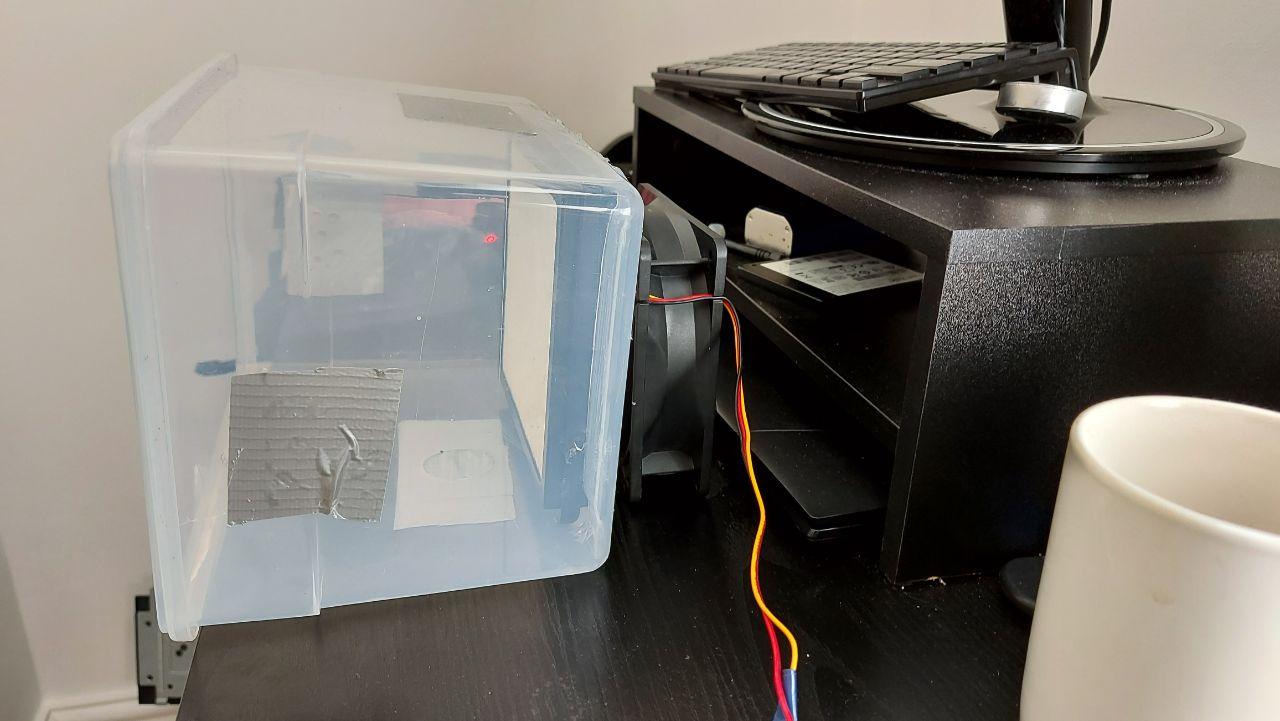
As you can see it’s kind of a janky setup. If you have the funds and are serious about mushrooms it probably makes more sense to buy one of the above recommendations!
Best Filter for a Laminar Flow Hood?
The best filter is one that is sized correctly to cover the entire back of the box, otherwise eddies may form—but the bigger the filter, the stronger the fan must be. The filter also have an efficiency rating of 99.97 % at 0.3 microns or better. That means that even particles only three tenths of a micron across get stopped 99.97% of the time. Yes, that means a HEPA filter, but not just any HEPA filter will do. Only a deep-seated filter will produce reliable laminar flow.
It’s also a good idea to use a smaller, cheaper filter across the intake of the fan as a pre-filter—it will remove larger particles, meaning it will clog up semi-frequently (and need replacement) so the expensive HEPA won’t have to. A cut-to-fit vent filter should work.
When the fan can no longer maintain adequate airflow, it’s time to change the pre-filter. If that doesn’t solve the problem, the HEPA filter will need to be changed. How soon these filter changes will arrive really depends to some extent on how clean your air is and how often you use the hood, but the filter manufacturer should also provide a recommended time-table for filter replacement.
This Hepa filter has all of those specs.
Best Fan for a Laminar Flow Hood?
Choosing the right fan begins with calculating the combined static pressure of the filters. “Static pressure” is how hard air needs to push to get through something. You need a fan capable of pushing air hard enough that it not only gets through both filters but also moves at 100 feet per minute (CFM) through the work area of the hood. Since fans are rated based on their ability to move a certain number of cubic feet per minute at a static pressure of zero, you’ll need to do some basic math and consult a performance curve—not difficult, but perhaps a little more involved than some DIYers would prefer.
I can’t recommend a specific fan for this application but there are a wide variety of fans that are 100 CFM and over. Again if trying to figure out these components isn’t something you want to spend your time doing, buy one of the ready made options above.
How to Use a Laminar Flow Hood
A flow hood won’t do much good if it’s not used properly.
Before use, clean the inside of the hood. Turn on the fan well ahead of time so that the moving air can push away any dust or mold spores that have settled on the filter face. Once the fan has run for a few minutes, spray the inside of the hood with alcohol (with the fan running). Make sure everything that goes into the hood has been sterilized (except, of course, living fungal tissue!) and wash your hands well. Make a habit of keeping your hands downwind of the materials you want to keep uncontaminated—that way, if something is on your hands that shouldn’t be, it won’t get wafted into your project.
Also, remember that everything you want to keep uncontaminated has to be properly sealed up before you remove it from the hood. There is no sense getting halfway through your work only to realize you forgot to bring a lid for something!
Cleaning and Maintaining a Laminar Flow Hood
Research labs and other professional settings have strict protocols for how and when to clean their laminar flow hoods[v], but that is in part due to that fact that many of them are working with either biohazardous materials or dangerous chemicals. For example, the person doing the cleaning may have to wear full PPE (personal protective equipment) and follow specialized procedures for the disposal of used wipes and so forth. Should you be using your flow hood for any such dangerous work, you should follow such protocols exactly.
However, mushroom growers seldom need to protect themselves from their work. It’s only the work that needs to be protected from everything else. It should be enough to clean the flow hood with alcohol before and after each use. Do not touch the filters. Do not attempt to clean the filters (except by running the fan before use). Be sure to wipe back and forth in overlapping strokes so that every inch gets covered. Wiping in circles makes it easy to miss spots. Also, wipe down the ceiling first (unless the ceiling IS the filter). If you did the floor first, then contaminants knocked off the ceiling could re-contaminate the floor.
Maintenance consists only of changing the filters as needed and making sure the fan is working properly[vi]. Just be aware of how the hood is working—if it stops flowing well, or if the fan sounds “off,” you may need a new fan.
Laminar Flow Hood (LFH) vs Biological Safety Cabinet (BSC)
A biological safety cabinet is essentially a laminar flow hood that is designed to protect the worker as well as the project[vii]. Some writers refer to BSCs as laminar flow hoods, since they do use laminar flow, others differentiate between the two carefully. In any case, mushroom growers do not need a BSC.
Laminar Flow Hood (LFH) vs Fume Hood
A fume hood collects dangerous fumes from the work area and vents them outside—generally without filtration[viii]. This is in contrast to most BSC-type flow-hoods that collect air, filter it, and release it back into the lab. Mushroom growers do not need fume hoods.
Frequently Asked Questions (FAQ)
What is an ISO Class 5 Laminar Flow Hood?
ISO classes reflect the maximum number of particles 0.5 microns or larger found per cubic foot of air inside the flow hood. Most hoods are in Class 4 or Class 5. A Class 5 hood has no more than 100 particles per square foot[ix].
What should the air speed be?
100 feet per minute.
What direction should the air flow?
For a sterile work area, the air should flow towards the worker. Set-ups designed to protect the worker from the project flow the other way.
How often should a LFH be inspected?
Inspected by whom? Flow hoods used in an industrial setting must be inspected regularly according to a schedule set by the employer, manufacturer, or sometimes a regulatory agency. But an independent mushroom grower working from home has circumstances that differ from the industrial in several important ways. First, there is no supervisor or maintenance team who is going to come in for scheduled inspections. The worker is responsible for maintaining their own equipment. Second, the flow hood is likely not being used very frequently. Scheduled inspections make less sense. The independent worker should therefore make sure the unit is functioning properly before beginning work every time.
References:
[i] (n.d.). Horizontal vs. Vertical Laminar Flow Hoods. Lab Supply Network
[ii] Killermemestar69XD (2022). Laminar Flow Hood: Build or Buy?
[iii] Shields, T. (n.d.). Keeping It Clean: How to Design and Build a Laminar Flow Hood
[iv] (n.d.). How to Make a Cheap Laminar Hood
[v] Blue Thunder Technologies (2019). The Process of Cleaning a Laminar Airflow Hood. Blue Thunder Technologies
[vi] Michelle, M. (2017). Maintenance Requirements for a Laminar Flow Hood. BizFluent
[vii] (n.d.). Laboratory Hoods—What’s the Difference? Environment, Health & Safety: University of Michigan
[viii] Ibid.

